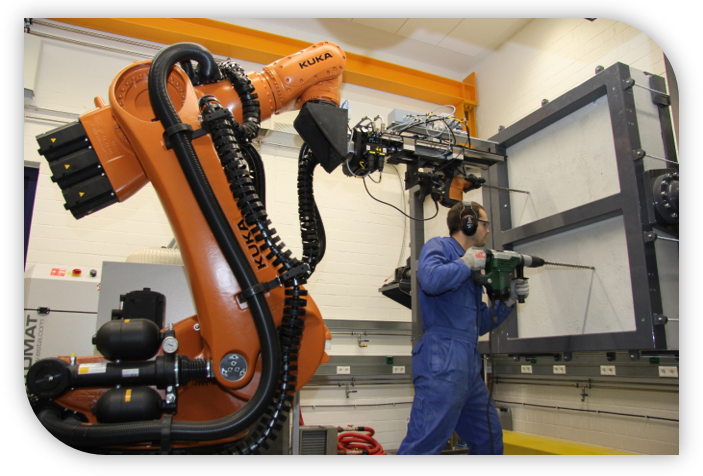Power Tools
In the research field of power tools, we are investigating methods to support the development process of handheld power tools. The term power tool is understood to mean the system made up of handheld tools (hammer drills, angle grinders etc.), tools (drills, grinding wheels etc.) and consumables (dowls, screws etc.). We focus on the development of measurement, modeling and validation methods. We use the system-independent IPEK-X-in-the-loop approach.
In the development of measurement, modeling and validation methods, the understanding of the overall system, consisting of user, machine, environment and application, plays a central role. This understanding is the basis for the derivation of the design targets to the machine elements used in the product and a driver for innovations in hand-held power tools.
Research Focus
- Investigation of the interaction between user and hand-held device
- Validation environments for power tools and their components
- Research and Development of workpiece substitution systems
- Investigation of impact torque procedures
- Machine Learning and Industry 4.0 in the environment of hand-held power tools
Systems
- System Power tools
- angle grinders, hammer drills, cordless drill drivers, impact drivers, direct fastening tools etc.
- Subsystems
- Gear units
- Clutch systems
- Drive motors
- Commutator systems
- Mechatronic systems
- Battery systems
Methods
Methods of validation for:
- Hand-held power tools
- Subsystems and components of hand-held power tools
- Tools and consumables
- Identification and modeling of the interaction with the user
- Identification and modelling of the interaction with the environment
- Identification of functional quality and usability
XiL-Framework for the consistent validation of technical systems:
- Innovative simulation environments
- Innovative testing environments
- Innovative systems to substitute the systems user and workpiece
Processes
- Development and validation processes
- Processes for evaluating the usability of power tools
Equipment
Test benches and laboratories
- Test benches of user interaction for investigation of user properties
- Test benches of automatised power tools for robot-controlled device validation
- Test benches of power tool components
- Scaled-components-in-the-Loop testbench for the development of performance scaling models
- Power tool test center for hand-held tests and evaluation of usability
- Laboratory for construction and wear analysis of power tools and their components
Portable Measurement equipment
- Portable capacitive pressure measuring foils for force measurement between user and hand-held power tool
- Force measurement in machine handles for force measurement between user and hand-held power tool
- 6-axis force plate for measuring the forces from the user to the ground
- Dust sensor for measuring application-related emissions
- Portable data acquisition system for data acquisition in the field
- 3D scanner for reverse engineering on power tools
- Fiber optic measuring device for detecting strain in power tool housings
- 3D motion tracking system to track user movement and posture while working with the power tool
Further equipment of the institute you findhere
Publications within the Research Field
Uhl, M.; Bruchmüller, T.; Matthiesen, S.
2019. International journal of industrial ergonomics, 72, 398–407. doi:10.1016/j.ergon.2019.06.016
Dörr, M.; Ries, M.; Gwosch, T.; Matthiesen, S.
2019. 29th CIRP Design Conference: open design and design as exponential technology, Póvoa de Varzim, Portugal, 8th to 10th May 2019
Dörr, M.; Zimprich, S.; Dürkopp, A.; Bruchmüller, T.; Gittel, H.-J.; Matthiesen, S.; Pelshenke, C.; Dültgen, P.
2019. 11th TOOLING 2019 conference & exhibition, Aachen, Germany, 12 - 16 May 2019
Horn, S.; Hoelz, K.; Schwabe, M.; Matthiesen, S.
2019. Beton- und Stahlbetonbau, 99 (7), 561. doi:10.1002/best.201900013
Gwosch, T.; Steck, M.; Matthiesen, S.
2019. ASIM – Simulation technischer Systeme, Braunschweig, 21. Februar 2019 - 22. Februar 2019. Hrsg.: Umut Durak, Christina Deatcu, Jan Hettwer, 163–168, ARGESIM
Germann, R.; Jahnke, B.; Matthiesen, S.
2019. Applied ergonomics, 75 (75), 170–177. doi:10.1016/j.apergo.2018.10.001
Matthiesen, S.; Germann, R.
2018. Procedia CIRP, 70, 241–246. doi:10.1016/j.procir.2018.02.040
Matthiesen, S.; Wettstein, A.; Sturm, C.
2018. Schraubenverbindungen 2018 - 6. VDI-Tagung, Würzburg, 21. - 22. November 2018, VDI Verlag
Matthiesen, S.; Wettstein, A.; Grauberger, P.
2018. Proceedings of NordDesign: Design in the Era of Digitalization, NordDesign 2018, The Design Society
Heyden, E.; Lindenmann, A.; Oltmann, J.; Bruchmueller, T.; Krause, D.; Matthiesen, S.
2018. Book of Abstracts. Symposium Lightweight Design in Product Development (LWD-PD18), Zurich, CH, June 14-15, 2018. Ed.: Paolo Ermanni, 44–46, Laboratory of Composite Materials and Adaptive Structures (CMASLab)
Matthiesen, S.; Gwosch, T.
2018
Matthiesen, S.; Lindenmann, A.; Bruchmüller, T.
2018. 7. VDI-Tagung Humanschwingungen 2018, Würzburg, 24.-25. April 2018, 91–106, VDI Verlag
Matthiesen, S.; Grauberger, P.; Sturm, C.; Steck, M.
2018. Procedia CIRP, 70, 475–480. doi:10.1016/j.procir.2018.03.039
Matthiesen, S.; Mangold, S.; Bruchmueller, T.
2018. Forschung im Ingenieurwesen. doi:10.1007/s10010-018-0269-x
Matthiesen, S.; Grauberger, P.; Hölz, K.; Nelius, T.; Bremer, F.; Wettstein, A.; Gessinger, A.; Pflegler, B.; Nowoseltschenko, K.; Voß, K.
2018. Karlsruher Institut für Technologie (KIT). doi:10.5445/IR/1000080744
Matthiesen, S.; Mangold, S.; Germann, R.; Schäfer, T.; Schmidt, S.
2018. Forschung im Ingenieurwesen, 82, 1–12. doi:10.1007/s10010-018-0265-1
Matthiesen, S.; Gwosch, T.; Mangold, S.; Dultgen, P.; Pelshenke, C.; Gittel, H.-J.
2017. Konstruktion, 69 (7-8), 76–81
Matthiesen, S.; Gwosch, T.; Mangold, S.; Grauberger, P.; Steck, M.; Cersowsky, S.
2017. Stuttgarter Symposium für Produktentwicklung 2017 (SSP 2017) : Produktentwicklung im disruptiven Umfeld, Stuttgart, Deutschland, 29. Juni 2017
Matthiesen, S.; Germann, R.; Schmidt, S.; Hoelz, K.; Uhl, M.
2016. Technische Unterstützungssysteme, die die Menschen wirklich wollen : Zweite Transdisziplinäre Konferenz - Hamburg, Germany, 12.-13. Dezember 2016. Hrsg.: R. Weidner, 223–232, Helmut-Schmidt-Universität/Universität der Bundeswehr Hamburg
Matthiesen, S.; Mangold, S.; Zumstein, T.
2016. 6. VDI-Tagung Humanschwingungen 2016 : Würzburg, Germany, 26.-27. April 2016, 95–110, VDI Verlag
Matthiesen, S.; Gwosch, T.; Schäfer, T.; Dültgen, P.; Pelshenke, C.; Gittel, H.-J.
2016. Forschung im Ingenieurwesen, 80 (1), 17–27. doi:10.1007/s10010-016-0203-z
Matthiesen, S.; Mangold, S.; Bruchmüller, T.; Marko, A. M.
2014. Design for X : Beiträge zum 25. DfX-Symposium. 25th Symposium Design for X, DFX 2014, Bamberg, Germany, 1. October - 2. October 2014, 193–204

